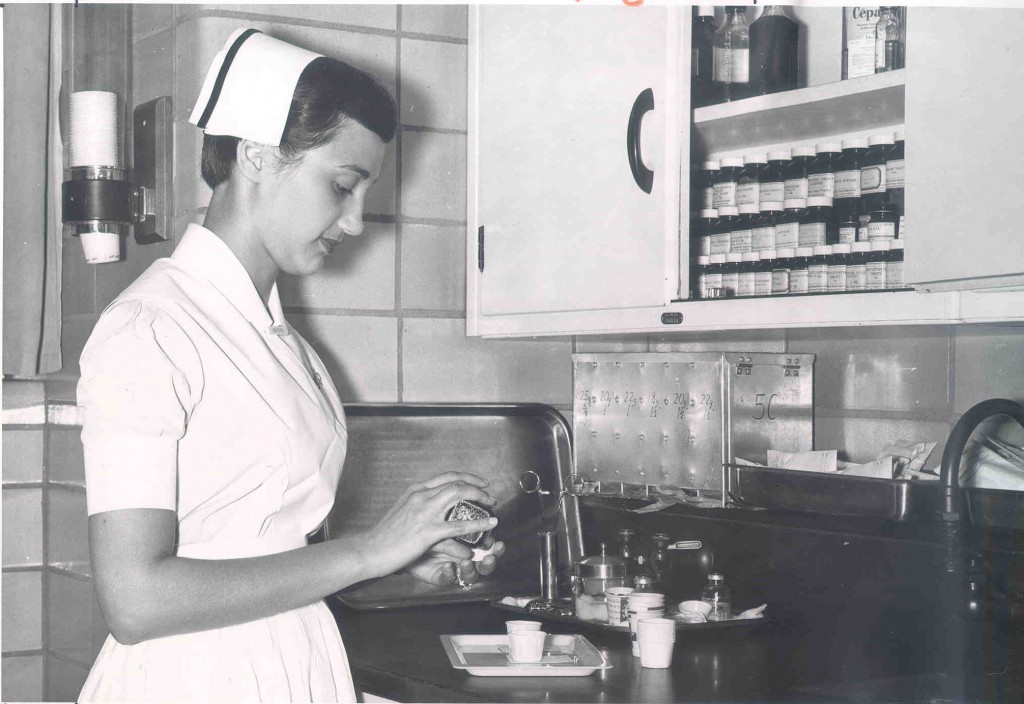By Lisa Wood, MLS
Archivist
I joined the staff of the Medical Heritage Center just three months ago. In that short time, I have become immersed in and increasingly informed about the history of women and medicine, particularly nursing history. Nursing was established as a modern profession fully open to women by Florence Nightingale and its history is a significant collecting area for the Medical Heritage Center. With the valuable assistance and input of our Friends of Nursing History Steering Committee, the Center has grown varied holdings related to nursing history. Records we hold from nursing organizations give a broad view of the field in Ohio:
- Alpha Tau Delta Records
- Cassandra Radical Feminist Nurses Records
- Mid-Ohio District Nurses Association Records
- Ohio Nurses Association Records
- The Ohio State University College of Nursing Records
- Sigma Theta Tau Records
I find the collections from individual nurses that illustrate their personal experiences attending nursing school and working in the profession the most interesting. It is especially exciting to hear nurses tell their stories in their own voices. The Nursing Oral Histories Collection contains recordings of interviews with over 50 Ohio nurses.
As the archivist responsible for processing personal papers, I have had the honor of working with my colleagues to arrange and describe collections for eight individual nurses:
- Debbie Ann Cannon Freece, MS, RN, CNS Papers
- Rachel L. Falls Waugaman Papers
- Kathryn A. Peppe, MS, RN Papers
- Annrose Domin Reichert Papers
- Ruth Bope Dangel Papers
- Karen Lane, RN, MA Papers
- June M. Lownie Radcliff, RN Papers
- Carol Ann Lemley Huffman, RN Papers
Becoming familiar with these collections, and others on the MHC shelves, there are a few things that I have noticed. An obvious difference between nursing in the 2020s and nursing in previous decades is their uniforms. While we are used to seeing nurses in scrubs and clogs or sneakers today, it was not that long ago they wore wool capes, dresses, polished white shoes and starched caps. In fact, receiving their first cap in nursing school, an event known as a capping ceremony, was a milestone. I have found caps, still very stiff with starch, in multiple collections. Shoes are not as commonly donated, but Ruth Bope Dangel did donate her white nursing shoes – still white and still in their original box.
In the tradition of Florence Nightingale, who began nursing on the battle fields of the Crimean War, I see that military service has continued to be part of some nurses’ careers. Annrose Domin Reichert enlisted in the U.S. Army Student Nurse Program before she had graduated from nursing school. For twin sisters June Lownie Radcliff and Joyce Lownie Davis nursing and military service became their joined life story. First, they attended nursing school together, then they enlisted. When called to active duty in February 1953 during the Korean War they were stationed together at Fitzsimmons Army Hospital. After the war they continued to work and participate in veterans’ organizations as a pair.
Nurses can have as many or more letters after their names as doctors. In addition to the RN for ‘registered nurse,’ many also hold master’s degrees and doctorate degrees. These were just the abbreviations that I was familiar with prior to processing nurses’ papers. When I came across Debbie Ann Cannon Freece, MS, RN, CNS I was stumped by the meaning of CNS. A quick search informed me that it stands for Clinical Nurse Specialist and indicates a nurse has advanced training. Since I started working at the Medical Heritage Center I created and regularly add to a list of the abbreviations I find in medical collections.
Nurses do not only work in hospitals and doctors’ offices. Their expertise is valuable in numerous settings. Reading their curriculum vitae and resumes I see positions listed in public schools, local and state departments of health, social service agencies, assisted living facilities and companies and organizations that provide on-site care for employees. They also like to share their knowledge as instructors and administrators and by writing and publishing articles.
Nursing is of course not the only story about women in the Medical Heritage Center. There is much to learn from the archival collections about women as patients and numerous collections from individual women working as physicians, dentists, optometrists, and medical school faculty. So much that these will need to be subjects of additional posts! I cannot wait to further explore the collections and learn more.
If you have questions about Medical Heritage Center collections or would like to view collections, please email the Center at mhcmail@osumc.edu for reference services or to schedule an appointment.









Recent Comments